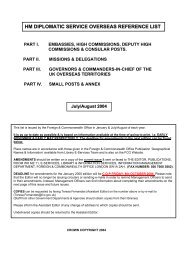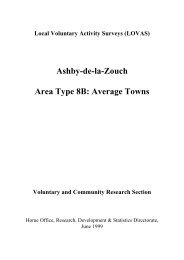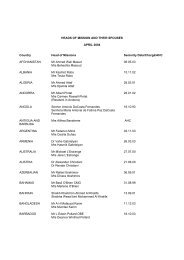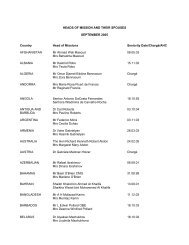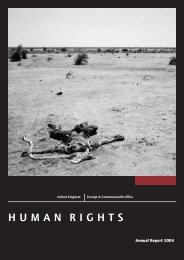A detailed guide to State Pensions for advisers and others
A detailed guide to State Pensions for advisers and others
A detailed guide to State Pensions for advisers and others
Create successful ePaper yourself
Turn your PDF publications into a flip-book with our unique Google optimized e-Paper software.
32<br />
What earnings count <strong>for</strong> additional <strong>State</strong> Pension?<br />
Earnings between the annual Lower Earnings Limit <strong>and</strong> the Upper Earnings Limit<br />
in each tax year from 6 April 1978 (or from the tax year in which their 16th<br />
birthday falls, if this is later) until the end of the tax year be<strong>for</strong>e the person<br />
reaches <strong>State</strong> Pension age.<br />
Example<br />
If Eddie reached his <strong>State</strong> Pension age in June 2008, his earnings between the<br />
tax years from 1978/79 <strong>to</strong> 2007/08 will count, but <strong>for</strong> Elwyn who reached his<br />
<strong>State</strong> Pension age in March 2008, his earnings will count <strong>for</strong> the tax years from<br />
1978/79 <strong>to</strong> 2006/07.<br />
Surplus earnings are those earnings above the Lower Earnings Limit (£90 a week<br />
<strong>for</strong> 2008/09) which is the level needed <strong>to</strong> qualify <strong>for</strong> basic <strong>State</strong> Pension. The<br />
amount of the surplus <strong>for</strong> each year (except the final year) is revalued in line with<br />
the rise in national average earnings.<br />
• For the period from 6 April 1978 <strong>to</strong> 5 April 1997 – the surplus earnings of all<br />
employees are counted.<br />
• For the period 6 April 1997 <strong>to</strong> 5 April 2002 – only the surplus earnings of<br />
employees who are not contracted out of the state scheme are counted.<br />
• For the period from 6 April 2002 <strong>to</strong> 5 April 2010 – <strong>for</strong> all employees, <strong>for</strong> each<br />
tax year the level of their surplus earnings are divided in<strong>to</strong> three b<strong>and</strong>s:<br />
– B<strong>and</strong> 1 is the surplus earnings above the Lower Earnings Limit <strong>and</strong> up <strong>to</strong> the<br />
Low Earnings Threshold;<br />
– B<strong>and</strong> 2 is from the Low Earnings Threshold <strong>to</strong> the Upper Earnings Threshold; <strong>and</strong><br />
– B<strong>and</strong> 3 is from the annual Upper Earnings Threshold <strong>to</strong> the Upper Earnings<br />
Limit. (The UEL is planned <strong>to</strong> be replaced by the UAP – see page 30.)<br />
• For the period from 6 April 2010 – <strong>for</strong> all employees, <strong>for</strong> each tax year the level<br />
of their surplus earnings are divided in<strong>to</strong> two b<strong>and</strong>s:<br />
– B<strong>and</strong> 1 is the surplus earnings above the Lower Earnings Limit <strong>and</strong> up <strong>to</strong> the<br />
Low Earnings Threshold; <strong>and</strong><br />
– B<strong>and</strong> 2 is from the Low Earnings Threshold <strong>to</strong> the Upper Earnings Limit.<br />
(The UEL is planned <strong>to</strong> be replaced by the UAP – see page 30.)<br />
Certain groups with no earnings or earnings below the Lower Earnings Limit are<br />
treated as having earnings at the Low Earnings Threshold.<br />
Family Credit or Disability Working Allowance received between 6 April 1995 <strong>and</strong><br />
4 Oc<strong>to</strong>ber 1999 are counted as earnings if the person reached <strong>State</strong> Pension age<br />
on or after 6 April 1999.<br />
Working Families’ Tax Credit <strong>and</strong> Disabled Person’s Tax Credit received between<br />
5 Oc<strong>to</strong>ber 1999 <strong>and</strong> 5 April 2002 are counted as earnings.<br />
Working Tax Credit <strong>and</strong> Children’s Tax Credit are not counted as earnings.




